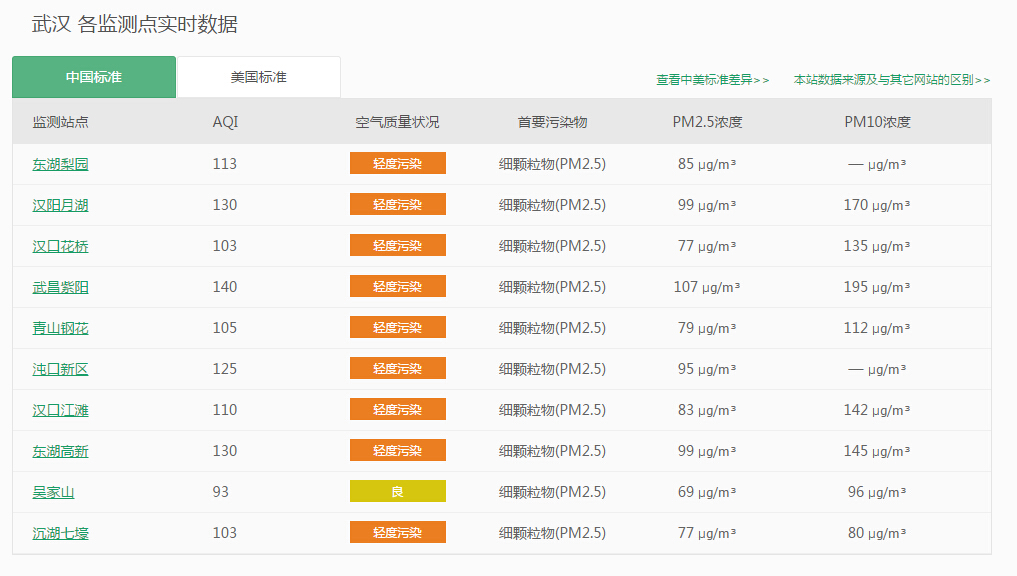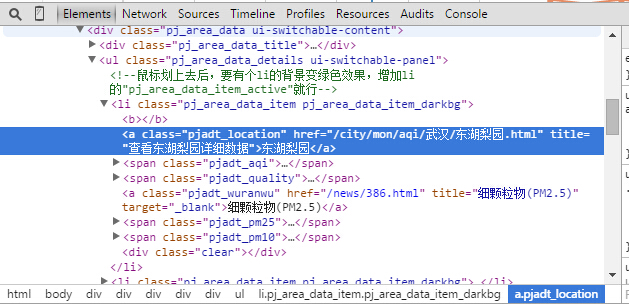Beautiful Soup is a Python library designed for quick turnaround projects like screen-scraping.总之就是一个解析xml和html之类的库,用着还算顺手。
官网地址:http://www.crummy.com/software/BeautifulSoup/
下面来介绍下使用python和Beautiful Soup 抓取一个网页上的PM2.5数据。
PM2.5 数据的网站:http://www.pm25.com/city/wuhan.html
这个网站上有相应的PM2.5数据,他们在几个地方布置的有监测器,大约每隔一个小时更新一次(有的时候,仪器的数据会丢失)。我们要抓取的数据就是几个监测点的一些空气质量指标。

1 def getPM25(): 2 url = "http://www.pm25.com/city/wuhan.html" 3 4 headers = { 5 "Accept":"text/html,application/xhtml+xml,application/xml;q=0.9,*/*;q=0.8", 6 "Accept-Language":"zh-cn,zh;q=0.8,en-us;q=0.5,en;q=0.3", 7 "Connection":"keep-alive", 8 "User-Agent":"Mozilla/5.0 (Windows NT 6.1; WOW64; rv:31.0) Gecko/20100101 Firefox/31.0", 9 } 10 try: 11 req = urllib2.Request(url,headers=headers) 12 response = urllib2.urlopen(req) 13 content = response.read() 14 response.close() 15 pm = BSoup(content,from_encoding="utf-8") 16 logging.info(pm.select(".citydata_updatetime")[0].get_text() + u" ") 17 with open('pm2dot5.txt','a') as f: 18 print>>f, pm.select(".citydata_updatetime")[0].get_text() 19 for locate in pm.select(".pj_area_data ul:nth-of-type(1) li"): 20 print>>f, locate.select(".pjadt_location")[0].get_text().rjust(15)," ", 21 locate.select(".pjadt_aqi")[0].get_text().rjust(15)," ", 22 locate.select(".pjadt_quality")[0].get_text().rjust(15)," ", 23 locate.select(".pjadt_wuranwu")[0].get_text().rjust(15)," ", 24 locate.select(".pjadt_pm25")[0].get_text().rjust(15)," ", 25 locate.select(".pjadt_pm10")[0].get_text().rjust(15) 26 print>>f, " " 27 return 0 28 except Exception,e: 29 logging.error(e) 30 return 1
主要使用python的库 urllib2
- 构造发送的headers,伪装成火狐浏览器
- 用上述数据构建一个请求,然后打开这个网络请求
- 调用 response.read() 即可获取html的内容
提取标签内容
下面就是使用Beautiful Soup来解析html内容,提取标签里的数值。具体函数还是要参见官方文档。
这里主要使用了select方法和get_text方法。
select方法可以根据标签名(tag,比如 a,li,body)或者css类或者id来选择元素。
get_text方法可以获取对应的文本,比如"<h1>hello</h1>",就可以获得 "hello"
具体的元素类,需要借助浏览器的审查元素功能来查看

写入文本:
主要使用了python的 with语法,with能够确保打开的文件发生异常时一定会被关闭。同时使用了一个流重定向的小技巧,
print >> f,"hello" f为打开的文件流,这句话的意思是将print打印的东西重定向到文件中。
日志记录:
由于这个程序要在后台跑很久,所以还是最好记录下出错的信息,方便调试。使用的python自带的logging模块。
1 logging.basicConfig(level=logging.DEBUG, 2 format='%(asctime)s %(filename)s[line:%(lineno)d] %(levelname)s %(message)s', 3 datefmt='%a, %d %b %Y %H:%M:%S', 4 filename='debug.log', 5 filemode='w') 6 console = logging.StreamHandler() 7 console.setLevel(logging.INFO) 8 formatter = logging.Formatter('%(name)-12s: %(levelname)-8s %(message)s') 9 console.setFormatter(formatter) 10 logging.getLogger('').addHandler(console) 11 Rthandler = RotatingFileHandler('debug.log', maxBytes=1*1024*1024,backupCount=5) 12 Rthandler.setLevel(logging.INFO) 13 formatter = logging.Formatter('%(name)-12s: %(levelname)-8s %(message)s') 14 Rthandler.setFormatter(formatter) 15 logging.getLogger('').addHandler(Rthandler)
其中包括了一些,设置日志的格式,以及日志文件的最大大小。
定时运行:
定时运行,可以每天抓取指定时间的PM2.5数据,结合卫星过境时间来做进一步的分析。定时使用的也是python自带的sched模块。
1 def run(): 2 while True: 3 s = sched.scheduler(time.time, time.sleep) 4 s.enterabs(each_day_time(9,50,30), 1, getPM25, ()) 5 try: 6 s.run() 7 except: 8 s.run() 9 time.sleep(60*60) 10 logging.info("second run") 11 while getPM25(): 12 pass 13 time.sleep( 60*60) 14 logging.info("third run") 15 while getPM25(): 16 pass 17 time.sleep(60*60) 18 logging.info("fourth run") 19 while getPM25(): 20 pass 21 logging.info(u" 等待下次运行...")
其中each_day_time是一个获取指定时间的函数
1 def each_day_time(hour,minute,sec): 2 today = datetime.datetime.today() 3 today = datetime.datetime(today.year,today.month,today.day,hour,minute,sec) 4 tomorrow = today + datetime.timedelta(days=1) 5 xtime = time.mktime(tomorrow.timetuple()) 6 #xtime = time.mktime(today.timetuple()) 7 return xtime
另外,如果指定的时间已经过去,他就会一直运行下去。
完整代码下载(python 2.7): https://files.cnblogs.com/files/pasion-forever/pm2-5.v1.rar
另:直接双击pyw文件,会调用pythonw.exe 来执行,如果没有GUI,默认的就是后台运行。
抓取的结果:
